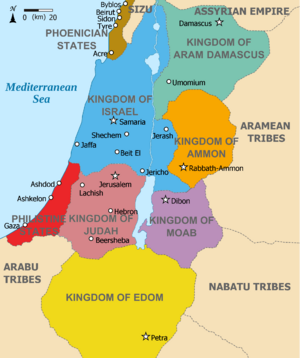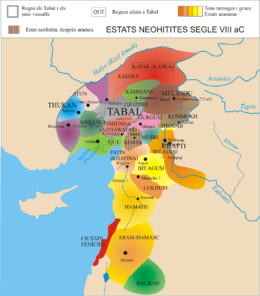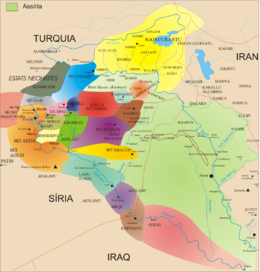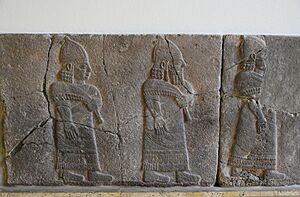Aram (region) facts for kids
Aram was an ancient land mentioned in old writings and the Bible. It was home to a people called the Arameans. This area, mostly in what is now Syria, wasn't one big empire. Instead, it was made up of many smaller kingdoms. One of the most famous was Aram-Damascus, often just called Aram in the Old Testament. It grew to cover much of Syria.
Over time, Aram lost its independence. Powerful empires like the Neo-Assyrian Empire, the Neo-Babylonian Empire (612–539 BCE), and the Achaemenid Empire (539–332 BCE) conquered it. Later, during the Seleucid Empire (312-64 BCE), the name Syria became popular for this region. This new name came from the Greeks.
The Aramaic language became very important. It replaced Akkadian as the main language for trade and government across the region. Even the early Christian Bible was translated into Aramaic. By the 4th century, a local Aramaic language from a city called Edessa became a special language for writing.
Contents
What Does the Name Aram Mean?
The name Aram describes the land where the Arameans lived. It means Highlanders or people from the high lands. Ancient texts mention the name "A-ra-mu" as early as 2300 BCE in the kingdom of Ebla. Another name, "Armi," was used for a nearby place.
Other old writings from places like Mari (around 1900 BCE) and Ugarit (around 1300 BCE) also mention Aram or Aramean people. Some texts talk about farmers from "Bīt-Aram," which was a region of Aram.
The word Aḫlamū was first used for the Amorites, then later for the Arameans. Sometimes, Assyrian kings would combine Aḫlamū and A-ra-mu to describe the Arameans.
Some old Jewish traditions say the name Aram comes from Aram, son of Shem. He was a grandson of Noah in the Bible.
A Brief History of Aram
The Arameans began to settle in ancient Syria between 1100 BCE and 900 BCE. This was a time of big changes and movements of people across the Near East. The Arameans became a very important group. From about 1200 BCE, the Amorites, who lived there before, started to disappear. The land they lived in became known as Aram.
The Arameans grew strong in a region mostly controlled by the Middle Assyrian Empire (1365–1050 BCE). They soon became a threat to the Assyrians. Tiglath-Pileser I (1115–1077 BCE), an Assyrian king, led many attacks against the Arameans. But his many campaigns show that Assyria struggled to control them. Some historians even think the Arameans might have captured the Assyrian city of Nineveh for a time.
In the 11th century BCE, the Assyrian Empire became weaker. This allowed the Arameans to set up many small kingdoms across the region. They even expanded into Assyrian lands, like the Khabur Valley. Between 1050 and 900 BCE, the Arameans controlled most of what is now Syria.
Rise of Aramean Kingdoms
During the early 1000s BCE, two larger Aramean kingdoms emerged: Aram-Damascus and Hamath. There were also many smaller kingdoms and independent cities. Some of these included Bit Adini, Bit Bahiani, Bit Hadipe, Aram-Rehob, Aram-Zobah, and Bit-Zamani.
In northern Syria, the Arameans mixed with other groups called Neo-Hittites. This led to the creation of small states known as Syro-Hittite states. Along the Mediterranean coast, powerful Phoenician city-states like Tyre and Sidon were dominant.
Under Foreign Rule
The Neo Assyrian Empire grew powerful again. From the mid-9th century BCE, they repeatedly invaded Aram. By the second half of the 8th century BCE, Aram was fully under Assyrian control. Many people from Aram were moved to other parts of the Assyrian Empire.
The Assyrians themselves started using a form of Aramaic called Imperial Aramaic. In the 8th century BCE, Tiglath-pileser III made it the official language of his huge empire. Some modern languages spoken today by Assyrians and Mandeans in the Middle East come from this ancient Aramaic.
Around 626 BCE, the Neo Assyrian Empire faced civil wars and became weak. A group of its former subjects attacked and destroyed it between 616 and 605 BCE. After this, the region of Aram was fought over by the Neo-Babylonian Empire and the Egyptians. The Babylonians won, and Aram became part of their empire (612–539 BCE). It was still called Eber-Nari then.
Later, the Persian Achaemenid Empire (539–332 BCE) conquered the Babylonians. They kept Imperial Aramaic as the main language and continued to call the region Eber-Nari.
Greek Influence and the Name "Syria"
In 332 BCE, the Greek ruler Alexander the Great conquered the region. After he died in 323 BCE, this area became part of the Seleucid Empire. The Greeks replaced Imperial Aramaic with Greek as the official language. They also changed the names Eber-Nari and Aramea. This area, and other parts of the former Assyrian Empire to the east, were renamed Syria (Seleucid Syria).
The name "Syria" came from a Greek word for Assyria. For centuries, "Assyria" had referred to the land of the Assyrians in what is now northern Iraq, northeastern Syria, southeastern Turkey, and northwestern Iran. It did not refer to most of modern Syria and Lebanon.
This led to some confusion later on. The Seleucids used the name "Syria" not only for Assyria itself but also for lands west of the Euphrates River. These western lands had mostly been home to Arameans, Phoenicians, and Neo-Hittites. When the Seleucids lost control of Assyria to the Parthians, the name "Syria" stuck. But it was then used only for the land west of the Euphrates. This meant both Assyrians and Arameans were sometimes called "Syrians" in Greek and Roman times.
This area, now called Syria, was fought over by the Seleucids, Parthians, Romans, and Persians. A powerful Aramean kingdom called Palmyra rose during this time. It resisted Roman and Persian attacks for a while. Eventually, the region came under the control of the Byzantine Empire.
Christianity began to spread from the 1st to 3rd centuries CE. The Aramaic language slowly replaced other local languages like Canaanite in Phoenecia and Hebrew in Palestine.
In the mid-7th century CE, the region was conquered by the Arab Islamic armies. Aramaic continued to be spoken by many people in Syria who did not adopt Arabic. However, today, the native Western Aramaic of the Aramean Christians in Syria is spoken by only a few thousand people. Most now speak Arabic. Eastern Aramaic, which has words from Akkadian, is still spoken by most Assyrians in northern Iraq, northeastern Syria, southeastern Turkey, and northwestern Iran.
Aramean Culture
After their kingdoms fell, many Arameans stayed in Northern Mesopotamia. They kept their culture and identity even under Muslim rule. In the early 20th century, over one hundred different Aramaic languages were spoken in the Middle East. These were used by Arameans, and also by smaller groups of Jews, Mandeans, and Muslims.
Ancient Aramean Religion
We don't have many records about the religion of the ancient Arameans. They mostly worshipped gods common to other Ancient Semitic-speaking peoples. Their most important god was Hadad, the god of thunderstorms and good harvests. He was also known as Ramman, meaning "thunderer." Another common name for him was Rahmana, meaning "merciful."
Aramean kings often mentioned Hadad as their protector. Hadad was usually shown as a bearded soldier holding thunder or a double-edged sword. The bull was his special animal, and he was often shown standing on a bull's back. Bull heads symbolizing Hadad can be seen on old coins from the 4th century BCE.
The main temple for Hadad was in Aram-Damascus. This temple had an interesting history:
- Under the Roman Empire, it was rebuilt as a Temple of Jupiter.
- During Byzantine times, it became a church.
- After the Arab conquest, it became the biggest mosque in modern Syria, called the Umayyad Mosque.
The name Bar-Hadad, used by several Aramean kings, means "son of Hadad." It was a royal title. Even after Arameans became Christians, they still used this name.
Aramean writings show they also worshipped other gods from Mesopotamia like Sin, Ishtar (called Astarte), Shamash, Tammuz, Bel, and Nergal. They also worshipped some gods from Canaan and Phoenicia, such as El, the main god of Canaan, and Anat.
Language of Aram
As the Arameans spread across Mesopotamia and the Levant, the Aramaic language became the main language for everyone in the Middle East. It was used for government, trade, and religious studies. Over time, it developed into several Neo-Aramaic languages that are still spoken today.
Aramean Art and Buildings
Aramean cities had strong walls and a fortified upper town, or citadel. Palaces and important buildings were on these citadels. The entrances to royal palaces often had statues of winged bulls or lions. These showed the king's power.
It's interesting that most major Aramean cities haven't shown temples on their citadels. One exception is a temple found in Tell Afis. The main temple of Sam'al was not in the capital city itself. It was on a rocky hill about seven kilometers away. This might mean they had different ideas about where to place religious buildings.
Aramean kings had unique hairstyles and beards in their art. They wore special headgear, had medium-length beards, and large curved noses. A braid hanging down in front of their headgear was a common feature in Aramean art.
See Also
- Arameans
- Aram-Damascus
- Aram-Naharaim
- Aramean kings
- Luwian-Aramean kingdoms
- Aramaic language
- Aramaic studies





